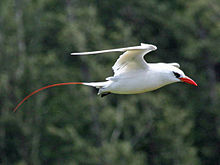| Red-tailed tropicbird | |
|---|---|

| |
| In flight, Kilauea Point, Kauai, Hawaii | |
| Scientific classification | |
| Domain: | Eukaryota |
| Kingdom: | Animalia |
| Phylum: | Chordata |
| Class: | Aves |
| Order: | Phaethontiformes |
| Family: | Phaethontidae |
| Genus: | Phaethon |
| Species: | P. rubricauda
|
| Binomial name | |
| Phaethon rubricauda Boddaert, 1783
| |

| |
| Range (in pink) | |
| Synonyms[2] | |
|
Phaethon phoenicuros Gmelin 1789 | |
The red-tailed tropicbird (Phaethon rubricauda) is a seabird native to tropical parts of the Indian and Pacific Oceans. One of three closely related species of tropicbird (Phaethontidae), it was described by Pieter Boddaert in 1783. Superficially resembling a tern in appearance, it has almost all-white plumage with a black mask and a red bill. The sexes have similar plumage. As referenced in the common name, adults have red tail streamers that are about twice their body length. Four subspecies are recognised, but there is evidence of clinal variation in body size—with smaller birds in the north and larger in the south—and hence no grounds for subspecies.
The red-tailed tropicbird eats fish—mainly flying fish and squid—after catching them by plunge-diving into the ocean. Nesting takes place in loose colonies on oceanic islands; the nest itself is a scrape found on a cliff face, in a crevice, or on a sandy beach. A single egg is laid, then is incubated by both sexes for about six weeks. The parents make long food-foraging trips of about 150 hours during incubation, but once the chick has hatched, the parents specialize their foraging: one forages for the chick for a few hours at a time, while the other makes much longer trips to feed themselves.
This bird is considered to be a least-concern species according to the International Union for Conservation of Nature (IUCN), though it is adversely affected by human contact. Rats and feral cats prey on eggs and young at nesting sites. The bird's tail streamers were once prized by some Hawaiian and Maori peoples.
- ^ BirdLife International (2020). "Phaethon rubricauda". IUCN Red List of Threatened Species. 2020: e.T22696641A163889221. doi:10.2305/IUCN.UK.2020-3.RLTS.T22696641A163889221.en. Retrieved 19 November 2021.
- ^ Gill, B.J.; Bell, B.D.; Chambers, G.K.; Medway, D.G.; Palma, R.L.; Scofield, R.P.; Tennyson, A.J.D.; Worthy, T.H. (2010). Checklist of the birds of New Zealand, Norfolk and Macquarie Islands, and the Ross Dependency, Antarctica (4th ed.). Wellington, New Zealand: Te Papa Press and Ornithological Society of New Zealand. pp. 136–37. ISBN 9781877385599.
